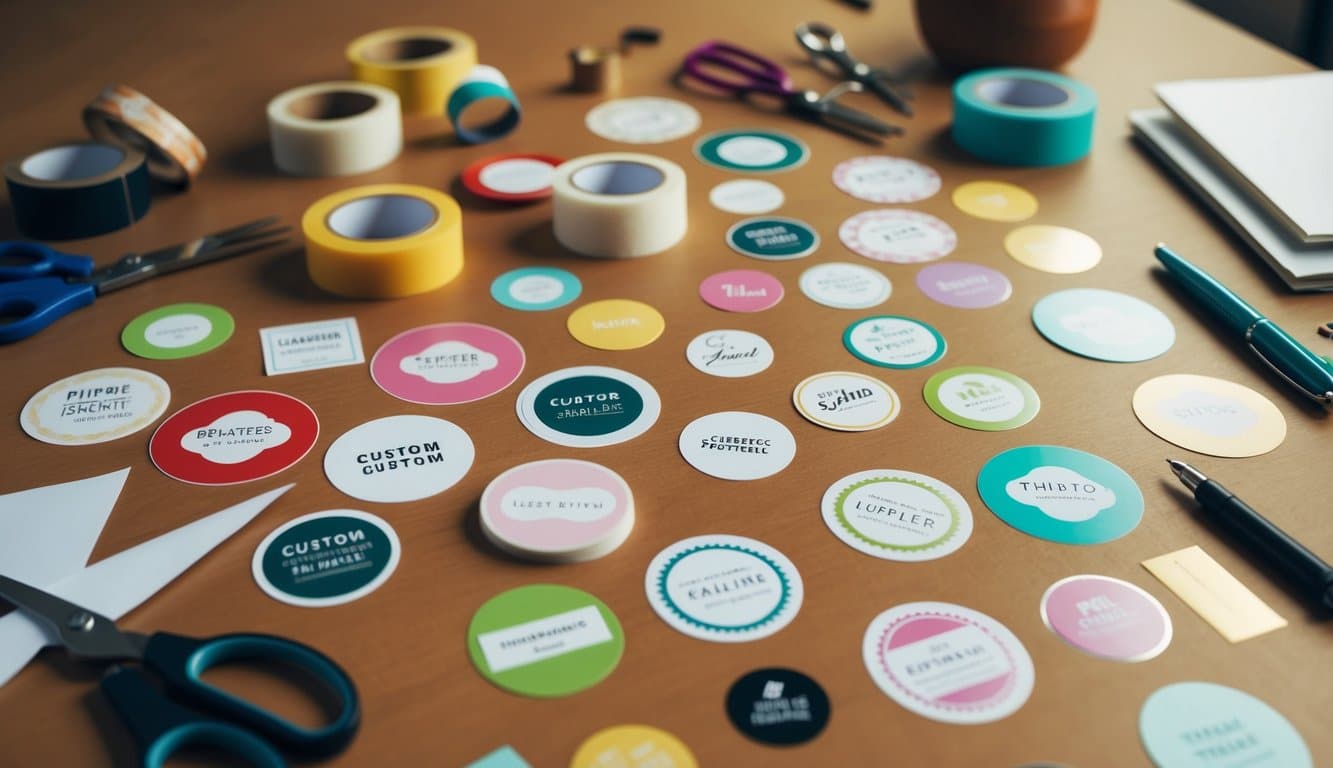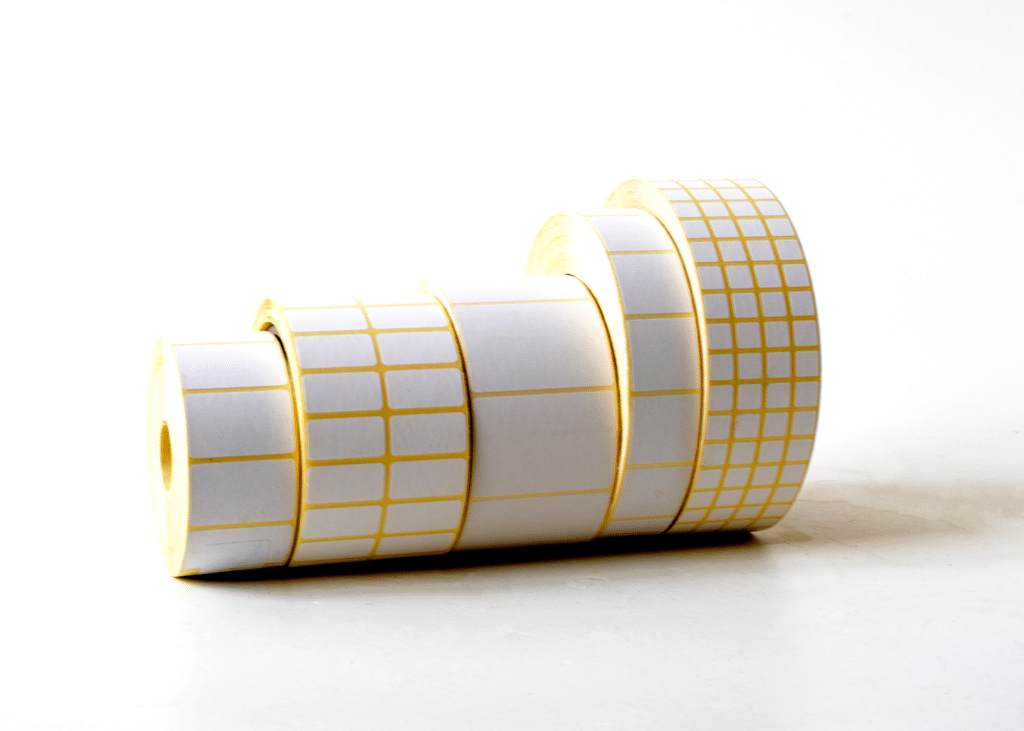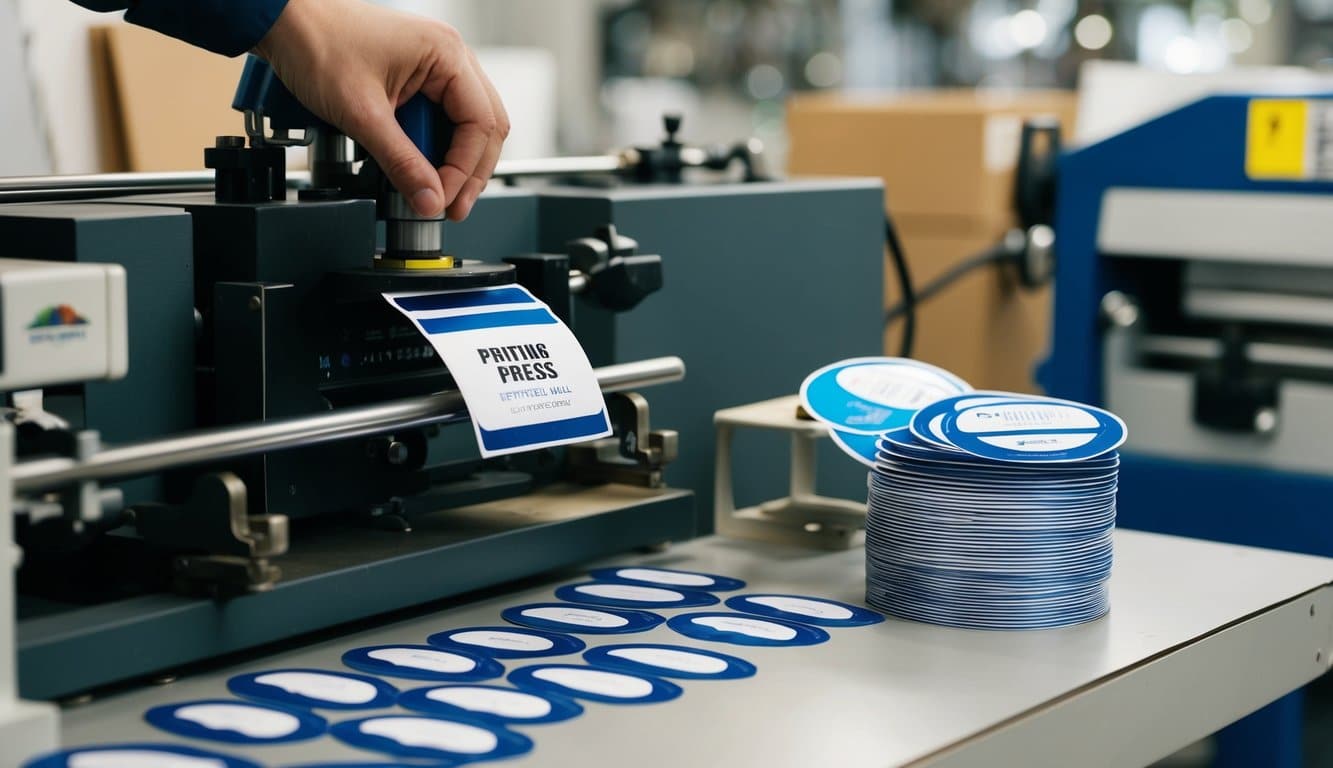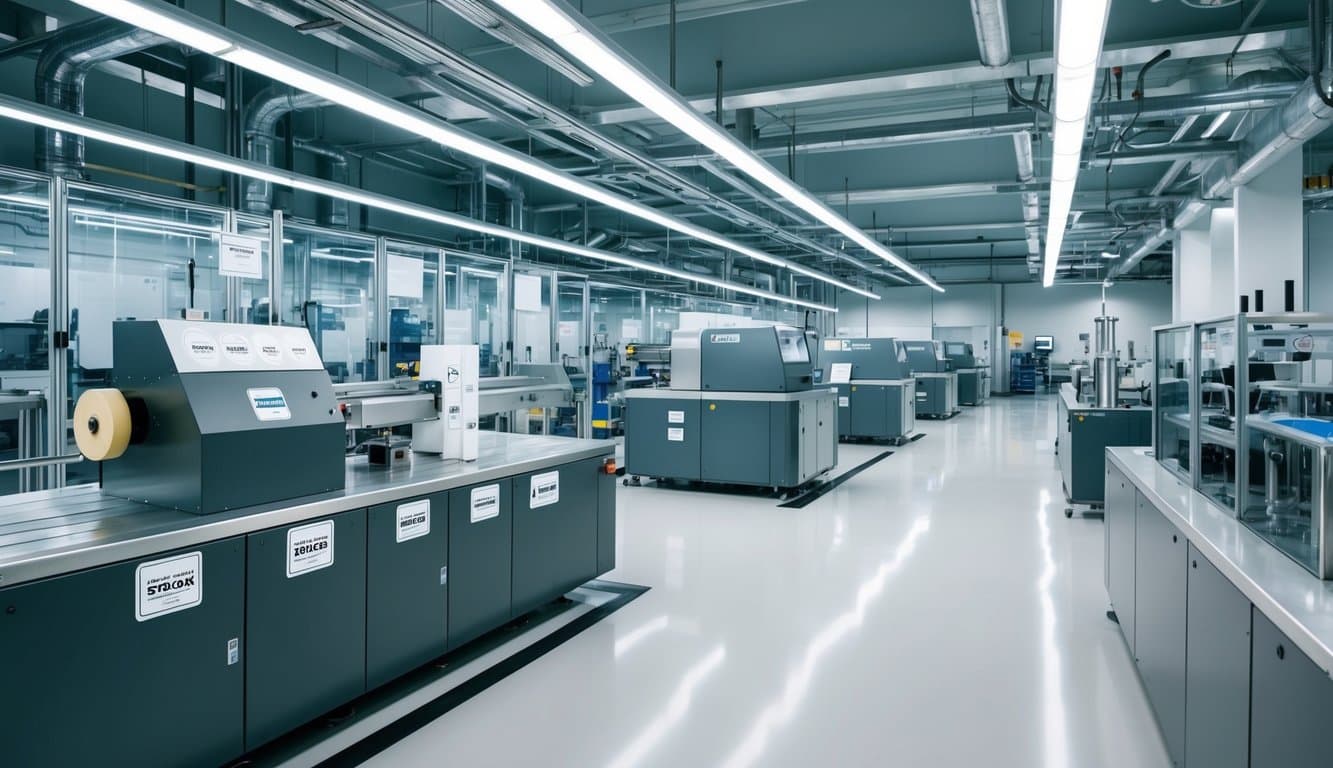Custom labels and stickers can significantly enhance product presentation and brand identity. They add a distinctive visual element that makes items immediately recognizable.
Whether you’re operating a small local business or managing a larger enterprise, understanding the fundamentals behind quality label and sticker production is essential.

Custom labels and stickers boost your brand recognition and product appeal. They come in many shapes, sizes, and materials.
You can pick from glossy, matte, or metallic finishes. This variety lets you match your brand’s style perfectly.
Producing custom labels and stickers can be straightforward and budget-friendly when you understand the available materials, adhesive types, and printing methods. This knowledge allows for well-planned projects that meet both quality and cost expectations.
You can apply them to packaging, products, or promotional items. They work well for both short-term campaigns and long-term branding efforts.
With the right design, your products will catch eyes and stay in customers’ minds.
Understanding Labels and Stickers
Labels and stickers serve as versatile tools that add both information and visual interest to a wide range of products. With options designed for various surfaces and purposes, they can be tailored to meet both practical and aesthetic needs.
Distinct Features
Labels focus on providing information. They often have text, barcodes, or other details about a product or item.
Labels stick firmly to surfaces for long-lasting use.
Stickers are more about decoration or branding. They can have colorful designs, logos, or fun images.
Stickers may be peeled off and reused in some cases.
Both labels and stickers use adhesive backing to stick to surfaces. The strength of the adhesive varies based on their purpose.
Material Choices
Labels and stickers can be made from different materials:
- Paper: Affordable and good for short-term use
- Vinyl: Durable and water-resistant
- Clear plastic: Gives a “no label” look
- Metallic foil: Adds a shiny, premium feel
The choice of material affects how long the label or sticker will last. It also impacts how well it resists water, sunlight, and wear.
Label and Sticker Sizes
You can find labels and stickers in many sizes:
- Tiny dots for pricing
- Medium squares for name tags
- Large rectangles for shipping labels
- Custom shapes for special designs
Size matters for both function and looks. A shipping label needs to be big enough to show all needed info.
A logo sticker should fit well on the item it’s decorating.
You can often order custom sizes to fit your exact needs. This helps you get the perfect fit for your project or product.
The Role of Customization in Branding

Custom labels and stickers help brands stand out and connect with customers. They let you add a personal touch to your products and packaging.
Benefits of Personalized Labels
Personalized labels make your products more memorable. They catch the eye and help customers recognize your brand quickly.
Custom labels also show attention to detail, which can boost perceived quality.
You can use personalized labels to:
- Match your brand colors and style
- Add special finishes like foil or embossing
- Include unique shapes or die-cuts
- Feature seasonal designs or limited editions
These touches help your products pop on shelves. They give customers a reason to choose your brand over others.
Incorporating Logos and Brand Icons
Your logo and brand icons are key parts of your visual identity. Custom stickers let you put these elements front and center.
You can use logo stickers to:
- Seal packaging
- Add branding to plain items
- Create promotional giveaways
Consistent use of your logo builds brand recognition. It helps customers remember and trust your products.
You can also create custom icon stickers for:
- Product features or benefits
- Certifications or awards
- Social media handles
These small touches reinforce your brand story and values.
Choosing the Appropriate Adhesive
The right adhesive makes a big difference in how well labels and stickers stick. It affects how long they last and if they can be removed. Let’s look at your options.
Permanent vs. Removable Adhesives
Permanent adhesives are great for long-term use. They stick well to many surfaces and don’t come off easily.
You might use them for product labels or safety stickers. These work well for roll labels that need to stay put.
Removable adhesives let you take off labels without leaving marks. They’re good for temporary uses.
You can put them on packages, windows, or walls. Removable white matte labels are popular for this. They look nice and come off clean.
Think about where you’ll put your label and how long it needs to stay. This helps you pick between permanent and removable options.
Specialty Adhesives for Unique Uses
Some labels need special adhesives. Freezer grade paper labels use adhesive that works in very cold temps. They stay stuck even when frozen.
There are adhesives for wet surfaces, like bottles that might get damp. Others work on rough or textured items.
You can find options for curved surfaces too.
High-temp adhesives are good for items that get hot. Low-temp ones work when it’s cold but not freezing.
Pick based on where you’ll use your labels.
Customization Options for Shapes and Sizes

Custom labels and stickers are available in a variety of shapes and sizes. Standard sizes suit many everyday applications, while unique die-cut designs offer creative flexibility for projects that require a distinctive look.
Standard Sizes and Die-Cut Shapes
Square and rectangular stickers are common choices. They come in sizes from tiny 1-inch squares to large 8×10 inch rectangles. Circle stickers range from 0.75 inches to 4 inches in diameter.
For unique looks, try die-cut shapes:
- Stars
- Hearts
- Ovals
- Triangles
- Custom outlines of logos or products
Die-cutting lets you create stickers in any shape you want. This works great for eye-catching designs that match your brand or message.
Leveraging Size for Maximum Impact
Bigger isn’t always better for stickers. Think about where you’ll use them.
Tiny stickers work well on small items like pens or phone cases. Large stickers grab attention on walls or vehicles.
Match the size to your design. Simple logos often look best on smaller stickers.
Detailed artwork may need more space to shine.
Consider practical factors too.
Will the sticker need to fit in a specific spot?
How far away will people view it?
Pick a size that’s easy to see and read from the intended distance.
Design Elements for Visual Appeal

The look of your custom labels and stickers matters. Good design helps them stand out and catch people’s eye.
Let’s explore some key design choices to make your labels pop.
Font and Typography Choices
Pick fonts that match your brand’s style. Sans-serif fonts like Arial or Helvetica work well for a clean, modern look.
Serif fonts like Times New Roman give a more classic feel.
Use no more than 2-3 fonts per design to avoid clutter.
Make sure text is easy to read. Choose font sizes that are big enough, even from a distance.
Avoid fancy scripts that may be hard to understand quickly.
You can add visual interest by mixing font weights. Try pairing a bold headline with lighter body text. This helps guide the reader’s eye to key info.
Color Schemes and White Space
Colors set the mood for your labels. Pick shades that fit your brand and product.
Bright colors grab attention, while softer tones feel more calm.
Use white space to make designs feel clean and uncluttered. This doesn’t mean the space must be white. It’s just the empty areas between design elements.
A white underlay can help colors pop on clear labels. For a sleek look, try white gloss paper with bold text.
Here’s a simple color scheme to try:
- Main color: 60%
- Secondary color: 30%
- Accent color: 10%
To better understand how design principles affect visual appeal, explore some of the resources available at Color Matters, which explain the impact of color and typography.
Using Free Templates for Consistency
Free templates save time and ensure your labels look polished. Many online tools offer pre-made designs you can customize.
Templates help keep your branding consistent across products. This builds trust with customers who learn to spot your items quickly.
Look for templates that fit your label shape and size.
Adjust colors and fonts to match your brand.
Add your logo and product info to make the design your own.
Some benefits of using templates:
- Professional look
- Time-saving
- Easy to update
- Maintain brand identity
Printing Techniques and Processes

Label printing has come a long way thanks to new technologies. Different methods offer unique benefits for creating custom stickers and labels.
Let’s explore the key techniques and services available.
Digital vs. Offset Printing
Digital printing works well for small batches of labels. It’s quick and allows for easy design changes.
You can print as few as one label at a time. This method is great for testing designs or making personalized stickers.
Offset printing shines for large orders. It produces high-quality labels at a lower cost per unit.
The setup takes longer, but it’s worth it for big runs. Offset printing gives sharp, consistent results across thousands of labels.
Both methods have their place. Your choice depends on order size, budget, and timeline.
Advancements in Label Printing
New tech has improved label printing in big ways. UV-curable inks dry instantly, speeding up production. They also resist fading and scratching.
Variable data printing lets you change text or images on each label. This is perfect for items with unique codes or personalized messages.
3D-effect labels are now possible with special lenticular printing. These eye-catching stickers seem to move or change as you look at them from different angles.
Vistaprint and Other Printing Services
Vistaprint offers easy online ordering for custom labels and stickers. You can upload your own designs or use their templates. They have options for various materials and finishes.
Other services like Moo and Sticker Mule focus on high-quality custom products. These companies often use premium papers and inks for a luxe feel.
Local print shops can provide hands-on help with your designs. They may offer faster turnaround for rush orders.
Online marketplaces like Etsy connect you with indie designers who create unique label styles.
Application Tips and Tricks
Proper application techniques ensure your custom labels and stickers look great and stay put.
Surface Preparation for Optimal Adhesion
Start with a clean surface. Wipe down the area with rubbing alcohol to remove dirt, dust, and oils. Let it dry completely.
For rough surfaces, sand lightly to create a smooth base.
Temperature matters too. Apply stickers when it’s between 50-80°F (10-27°C) for best results. Avoid extreme heat or cold, which can affect the adhesive.
For curved surfaces, measure carefully. You may need to trim the sticker slightly larger than the area to account for the curve.
Avoiding Common Mistakes
Take your time to avoid bubbles and wrinkles. Start at one edge and slowly press down, working your way across.
If you spot a bubble, lift the sticker gently and reapply.
Don’t stretch the sticker. This can cause it to peel off later. Instead, let it naturally conform to the surface.
Be careful with placement. Once stuck, most labels are hard to reposition without damage. Use painter’s tape to mark the spot first if you’re unsure.
Tools for Smooth Application
A squeegee is your best friend for large stickers. It helps push out air bubbles and ensures even pressure. Don’t have one? A credit card works too.
For tiny bubbles, use a pin to make a small hole. Then press down to release the air.
Scissors or a craft knife can trim excess material. Always cut away from yourself and use a ruler for straight lines.
Tweezers help with precise placement of small labels. They’re great for getting into tight corners or aligning intricate designs.
Maintenance and Durability

Custom labels and stickers need proper care to stay in good condition. The right maintenance helps them last longer in different settings.
Caring for Labeled Products
Keep labeled items clean to make the stickers last. Use a soft cloth with mild soap and water to wipe them gently.
Don’t scrub hard or use harsh chemicals.
For dry cleaning, dust the labels with a soft brush. This works well for fabric items with labels.
If a label starts to peel, press it back down. Don’t pick at loose edges. You can use a small amount of clear glue for extra hold.
Ensuring Longevity in Various Environments
Choose tear-resistant labels for items that get a lot of use. These labels hold up better to wear and tear.
For outdoor use, pick waterproof labels. They stand up to rain and sun. UV-resistant options prevent fading in bright sunlight.
Store labeled items away from heat and direct light when possible. This helps prevent curling or discoloration.
In humid areas, use labels with strong adhesive. They’re less likely to peel off. For very cold settings, make sure the label glue can handle low temps.
Labeling Regulations and Standards
Product labels must follow specific rules and laws. These vary by industry and country. Knowing the requirements helps ensure your labels are compliant.
Compliance with Industry-Specific Requirements
Different products need different label info. Food labels must list ingredients and nutrition facts. Chemicals require hazard warnings. Clothing tags should show care instructions.
The FDA regulates food and drug labels. The CPSC oversees labels for consumer goods. The FTC monitors truth in advertising claims on packaging.
Check with your industry’s regulatory bodies for exact rules. They often have detailed guides. Following these prevents fines and recalls.
Understanding International Labeling Laws
Selling products abroad? You’ll need to follow local laws. The EU has strict rules about chemical disclosures. Many countries require labels in their official language.
Some nations ban certain claims or images on packaging. Others have special recycling icons or disposal info requirements.
Research each market’s rules before exporting. Consider working with local experts. They can help navigate complex regulations. This ensures your labels meet all legal standards abroad.
Ordering and Customer Service Experience

Ordering custom labels and stickers can be simple with the right process. Good customer support makes a big difference before and after you buy.
Navigating Ordering Processes
When you order custom labels or stickers, you’ll first pick the size, shape, and material. Many companies offer templates to help with designs. You can also upload your own artwork.
Next, choose the quantity you need. Prices often go down for bigger orders. Some places have minimum order amounts.
Before checkout, double-check all details. Make sure the preview looks right. Most sites let you review a digital proof.
Payment options usually include credit cards and PayPal. Some companies offer bulk discounts or coupon codes.
Customer Support for Pre and Post-Purchase
Good customer service can help you before you buy. They can answer questions about materials or design tips. Some offer live chat for quick answers.
After you order, track your package online. If there’s a problem, contact support right away. Many places have phone, email, and chat options.
If you’re not happy with your order, check the return policy. Some companies offer reprints for mistakes. Others may give refunds.
For big orders, ask about samples first. This lets you check quality before buying a lot.
Cost Considerations and Budgeting
Custom labels and stickers can fit different budgets. Smart choices help you get quality products at good prices. Planning ahead lets you save money on larger orders.
Balancing Quality with Affordability
You can find affordable custom labels without giving up quality. Look for suppliers that offer different material options.
Vinyl stickers cost more but last longer outdoors. Paper labels work well for indoor use and cost less.
Think about how long you need the labels to last. Short-term use? Choose cheaper materials. Need durability? Spend a bit more on tougher options.
Some companies let you order samples first. This helps you test quality before buying in bulk.
Bulk Ordering and Price Breaks
Buying more labels at once often lowers the price per item. Many suppliers offer discounts on large orders. You might save 10-30% by doubling your order size.
Plan ahead to take advantage of bulk pricing. Figure out how many labels you’ll need over time. Order that amount at once if you can. Just make sure you have space to store extras.
Some companies have minimum order amounts for custom work. Shop around to find one that matches your needs. Joining forces with other small businesses can help you reach minimums and save money.
Expanding to Product Packaging and Beyond

Custom labels and stickers can do more than just identify products. They offer creative ways to enhance packaging and build your brand identity.
Innovative Uses for Stickers and Labels
Add stickers to boxes to create eye-catching designs. Use colorful labels on plain cardboard to make your packages pop. Try putting QR codes on stickers that link to product info or special offers.
Wrap envelopes with branded stickers for a polished look. Use clear labels to seal boxes and add a professional touch. Put fun stickers inside packages as a surprise for customers.
Try removable labels that customers can peel off and use. This gives your product extra value. Test out scented or textured stickers to engage more senses.
Creating a Unified Brand Experience
Use consistent colors and fonts on all your packaging. This helps customers recognize your brand quickly. Put your logo on boxes, envelopes, and products to reinforce brand awareness.
Match your packaging style to your company’s personality. If you’re playful, use bright colors and fun shapes. For luxury brands, stick to elegant, minimal designs.
Extend your branding to shipping materials. Custom tape and packing slips keep your look cohesive. Even small details like branded “fragile” stickers make an impact.
Consider eco-friendly options to show your values. Use recyclable materials and highlight this on your labels.
Future Trends in Labeling and Sticker Industry

The labeling and sticker industry is poised for exciting changes. New tech and eco-friendly practices are shaping its future.
Technological Innovations
Smart labels with QR codes will become more common. These will let you track products and give customers extra info.
Just a quick scan with a phone will reveal details about origin, ingredients, or usage tips.
Augmented reality (AR) labels are on the horizon. You’ll see labels that come to life through your phone’s camera.
This could include animated logos or virtual product demos.
Sustainability and Environmental Concerns
Eco-friendly materials are the future of labels. You’ll find more options made from recycled paper and plant-based plastics.
These will break down easier and leave less waste.
Water-soluble labels will gain popularity. You’ll be able to easily remove them from containers for better recycling.
This will help reduce plastic waste in our oceans.
Ink innovations will make labels safer for the environment. You’ll see more plant-based inks that don’t harm ecosystems.
These will be just as vibrant but kinder to nature.
Energy-efficient printing methods will become standard. You’ll use less power to create your labels, cutting both costs and carbon footprints.
Frequently Asked Questions
Custom labels and stickers have many uses for businesses and individuals. Let’s look at some common questions about costs, creation methods, and options.
How much does it cost to make custom labels?
The cost of custom labels varies based on quantity, size, materials, and printing method.
Small batches may cost $0.25-$1 per label. Larger orders often have lower per-unit costs.
Digital printing is cheaper for small runs, while offset printing saves money on big orders.
How can you create personalized label stickers?
You can make personalized label stickers at home or through online services.
At home, use label paper and a printer. Design your labels with software like Canva or Adobe Illustrator.
For professional results, speak to your local print shop or upload your designs to online sticker makers who will print and ship to you.
Is it more cost-effective to print your own labels or purchase them pre-made?
For small batches, printing your own labels is often cheaper. You save on setup fees and shipping.
For large quantities, pre-made labels from a professional printer are usually more cost-effective. They have better equipment and bulk discounts on materials.
What is the process for printing stickers and labels at home?
To print stickers at home:
1. Design your labels
2. Buy sticker paper
3. Load paper in your printer
4. Print a test sheet
5. Adjust settings if needed
6. Print your final labels
7. Let ink dry fully
8. Cut out individual stickers
Use the right paper for your printer type. Inkjet printers need different paper than laser printers.

